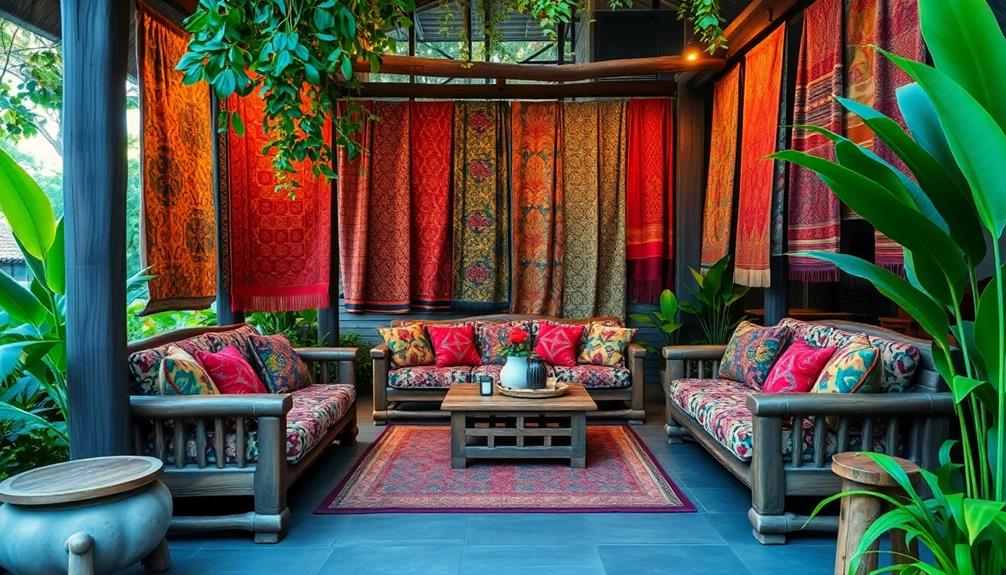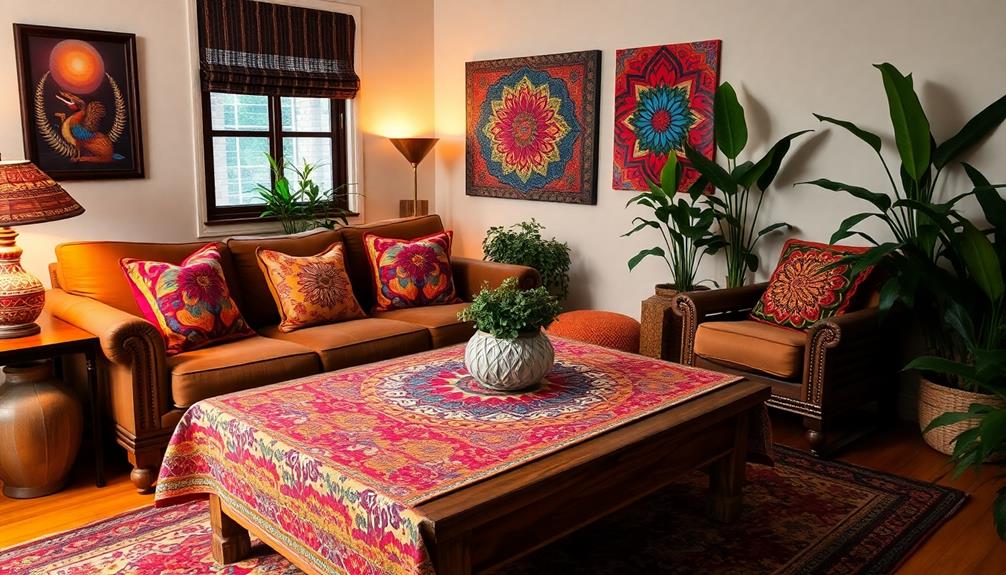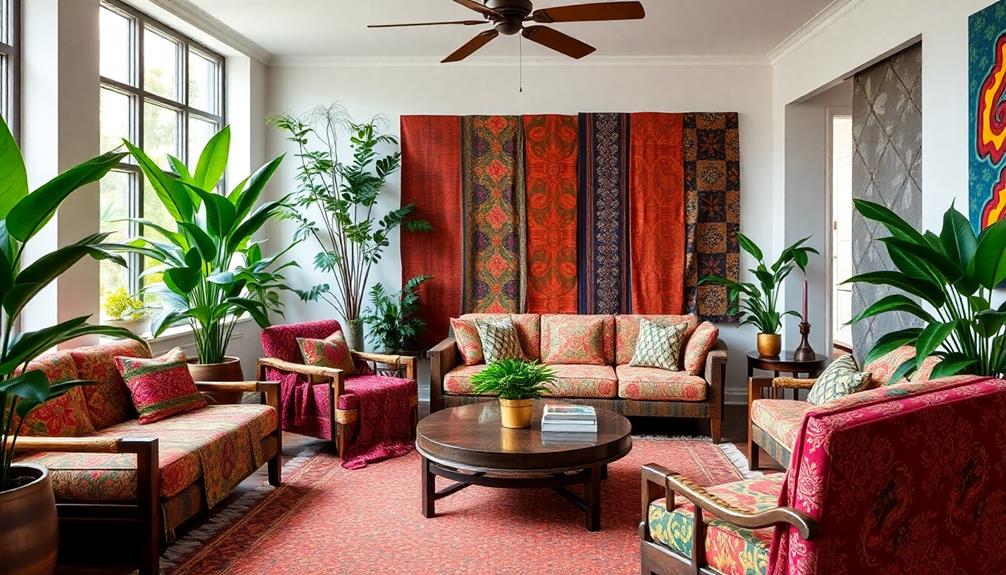Indonesian textiles showcase a deep cultural legacy that can add a touch of beauty to your home. From the exquisite techniques of batik, ikat, and songket, each piece weaves a unique narrative that blends tradition with contemporary design. These vibrant fabrics can be used as upholstery, table linens, or artwork to bring an air of sophistication to your living space. Their intricate patterns and rich colors offer versatility in decorating. With proper maintenance, these textiles will remain timeless treasures. Delve into the possibilities of incorporating this breathtaking elegance into your surroundings, and you’ll find limitless ways to honor their artistry and skill.
Key Takeaways
- Indonesian textiles, including batik and ikat, reflect rich cultural heritage and regional identities, enhancing home decor with historical significance.
- Unique weaving techniques and natural fibers contribute to the durability and comfort of Indonesian textiles, adding elegance to any space.
- Vibrant colors and intricate patterns make Indonesian textiles ideal for contemporary interior design, offering creative applications in upholstery and decor.
- Incorporating textiles into home decor preserves cultural legacy while showcasing the artistry of skilled artisans and traditional craftsmanship.
- Caring for Indonesian textiles involves proper cleaning and storage, ensuring they maintain their beauty and longevity in your home.
The Rich Heritage of Indonesian Textiles
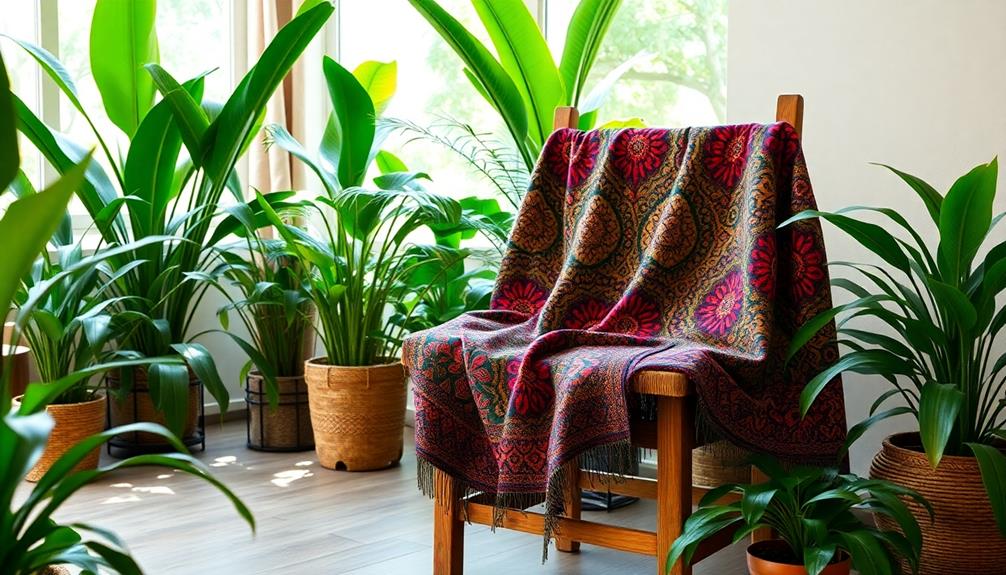
Indonesian textiles are more than just fabric; they embody the rich heritage of a vibrant culture. With deep roots tracing back to ancient traditions, these textiles like batik and ikat carry significant cultural importance. Each piece reflects a rich history, symbolizing status and identity within communities.
You'll find that the intricate designs of batik, created through a wax-resist dyeing technique, have earned recognition as a UNESCO Intangible Cultural Heritage. These motifs tell stories that reflect the beliefs and values of the people. Additionally, the use of traditional fabrics has become increasingly popular in contemporary interior design, allowing for a beautiful blend of the old and new, such as incorporating Indonesian decorative pillows that enhance living spaces.
Ikat, another remarkable textile, showcases one of the oldest resist-dyeing techniques in Indonesia. Its vibrant patterns serve as artistic expressions of cultural heritage, enchanting anyone who appreciates craftsmanship.
The regional diversity in Indonesian textiles adds another layer of richness; for instance, Batik Pekalongan features floral patterns, while Batik Solo displays mythological motifs. Each style represents unique cultural narratives, enhancing the overall significance of Indonesian textiles.
Incorporating traditional weaving techniques and materials like cotton and silk, artisans create pieces that are visually stunning and deeply meaningful. By embracing these textiles, you're not just decorating your space; you're honoring a tradition that spans generations.
Key Types of Indonesian Textiles
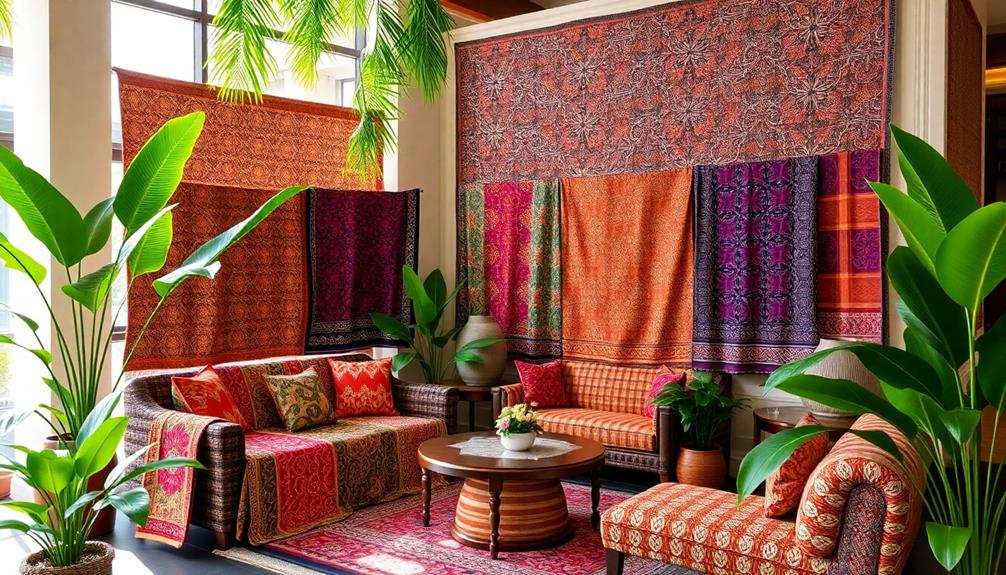
Exploring the diverse world of Indonesian textiles reveals several key types that showcase the country's rich artistic heritage. One of the most renowned is Batik, a wax-resist dyeing technique recognized by UNESCO, which beautifully reflects cultural significance and traditional craftsmanship.
You'll find various regional styles, such as Batik Pekalongan, celebrated for its vibrant colors, and Batik Yogyakarta, known for its elegant geometric motifs. Additionally, the intricate designs of Batik masks can also enhance your home decor aesthetics, offering a unique cultural touch to enrich your decor.
Another significant textile is Ikat, an ancient form where threads are bound and dyed before weaving, resulting in intricate patterns. This technique often holds ceremonial importance and symbolizes social status, making it a fascinating choice for your decor.
Don't overlook Tenun, which refers to handwoven textiles made mainly from cotton or silk. Each Indonesian region boasts unique weaving techniques and motifs that reflect local traditions.
Additionally, consider Endek, a Balinese textile that combines ikat dyeing and weaving, producing vibrant patterns ideal for clothing and home decor.
Finally, Songket, a luxurious fabric woven with gold or silver threads, is traditionally used for ceremonial attire, adding a touch of elegance to any setting.
Embrace these textiles to enrich your home's aesthetic and celebrate Indonesian craftsmanship.
Cultural Significance and Symbolism
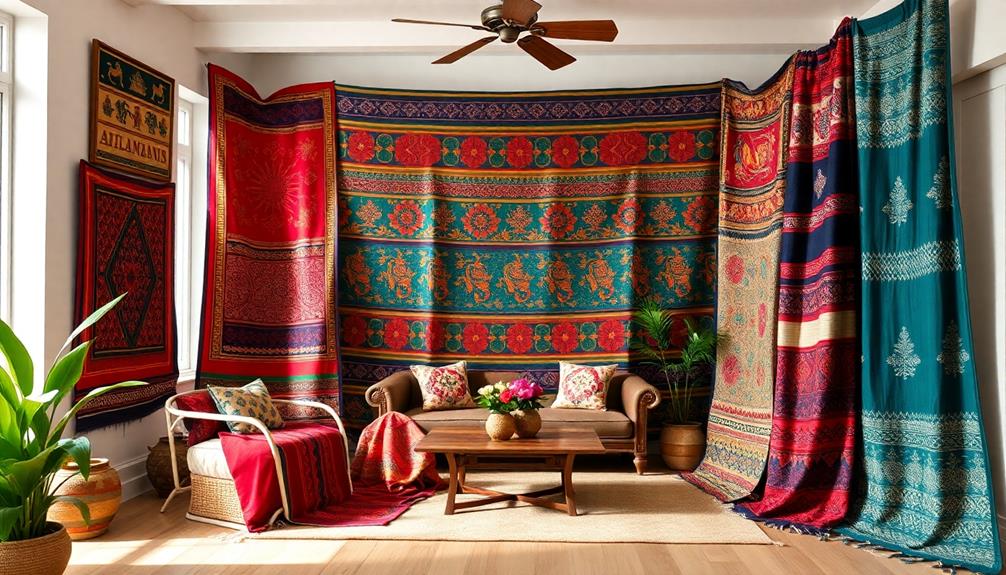
What makes textiles like batik and ikat so culturally significant? These fabrics aren't just beautiful; they're steeped in meaning and tradition.
Batik, recognized as a UNESCO Intangible Cultural Heritage, showcases intricate artistry through patterns that tell stories and convey cultural beliefs. Similarly, ikat textiles play an essential role in significant social events, reflecting the heritage of Indonesian craftsmanship.
Additionally, similar to the vibrant artistry found in Indonesian Decor Masks, these textiles also enhance the aesthetic appeal of your home while representing deep cultural narratives.
Here are some key aspects of their cultural significance and symbolism:
- Social Status: Different patterns often indicate the wearer's social rank and identity within their community.
- Ritual Connection: Textiles are used in rituals and ceremonies, marking important life events and cultural practices.
- Regional Identity: Each region has its distinctive designs, rich in unique meanings tied to local traditions and myths.
- Community Heritage: Wearing these textiles connects you to your roots and preserves your cultural legacy.
Incorporating batik and ikat into your home decor not only enhances your space but also honors the cultural significance and intricate artistry behind these timeless textiles.
Weaving Techniques and Materials

When you explore traditional Indonesian textiles, you'll notice the unique weaving methods that define their beauty.
Techniques like ikat, batik, and songket not only showcase intricate patterns but also highlight the use of natural fibers.
These textiles often reflect the rich cultural heritage and regional identity of Indonesia, similar to how traditional Indonesian housing incorporates distinct architectural styles that vary by region.
These materials, combined with skilled craftsmanship, create textiles that are both stunning and culturally significant.
Traditional Weaving Methods
Traditional Indonesian textiles showcase three primary weaving techniques: ikat, batik, and songket. Each method is a traditional weaving art form, deeply rooted in Indonesian culture and craftsmanship, much like the unique artistry found in Indonesian decor masks.
- Ikat Weaving: This technique involves dyeing threads before they're woven, creating intricate patterns through a resist-dyeing method. The resulting designs are vibrant and reflect local artistry.
- Batik: Using a wax-resist dyeing technique, artisans apply hot wax to fabric. This process allows for detailed patterns to emerge through multiple dyeing layers, showcasing both skill and storytelling.
- Songket: This luxurious textile is woven with gold or silver threads. It represents wealth and status and is often reserved for ceremonial contexts across various Indonesian cultures.
- Cultural Significance: Each weaving method carries its own cultural significance, reflecting the region's history and traditions.
Exploring these traditional weaving methods not only enriches your understanding of Indonesian textiles but also allows you to appreciate the craftsmanship behind each piece.
As you select textiles for your home, consider the stories and artistry woven into each fabric, making your decor truly unique and meaningful. From hand-loomed linens to intricately patterned rugs, each piece carries with it a rich history and craftsmanship that transcends mere function. Mixing styles, such as a “Marie Kondo farmhouse blend,” can seamlessly combine minimalist organization with the warmth and charm of rustic textures. In doing so, you create a balanced environment that not only sparks joy but also celebrates the tactile beauty of well-chosen fabrics.
Natural Fiber Utilization
Throughout history, Indonesian textiles have relied on natural fibers like cotton, silk, and ramie for their durability and comfort. These materials not only provide breathability but also serve as the foundation for stunning craftsmanship that aligns beautifully with Balinese design characteristics.
You'll find that the intricate weaving techniques of ikat, batik, and songket showcase the artistry of skilled artisans.
Ikat weaving involves pre-dyeing threads to create elaborate patterns, ensuring each piece tells a unique story. On the other hand, batik employs a wax-resist dyeing method, allowing for detailed designs that come to life on fabric.
Songket is particularly notable, as it features luxurious gold and silver threads, making these textiles highly sought after for ceremonial occasions.
The vibrant colors you see in Indonesian textiles come from traditional dyes derived from natural sources like plants, minerals, and insects. This connection to nature not only enhances the beauty of the fabrics but also pays homage to Indonesia's rich cultural heritage.
Incorporating Textiles Into Home Decor
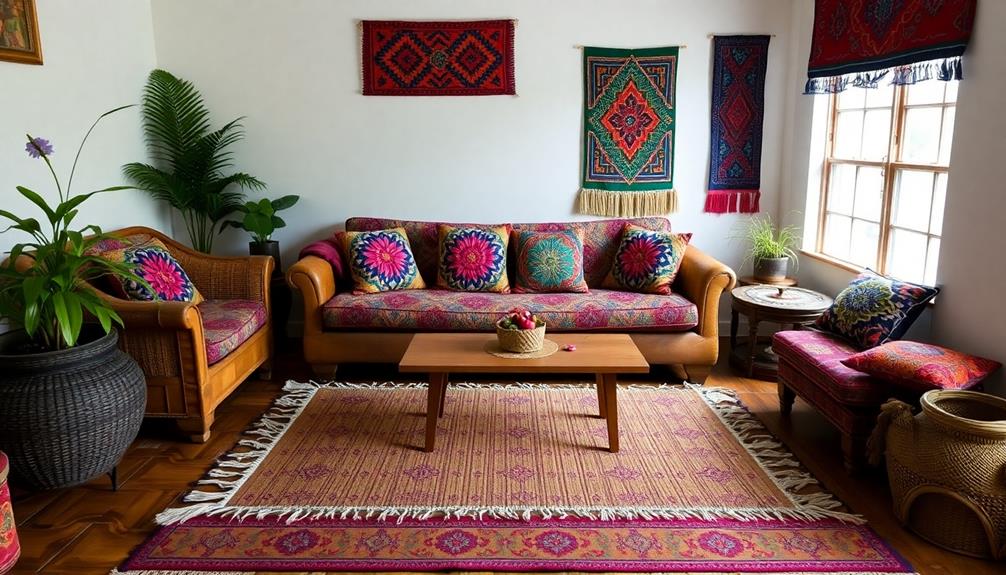
Indonesian textiles, like batik and ikat, can instantly transform your home decor with their vibrant colors and intricate patterns. By incorporating textiles into your space, you not only enhance the aesthetic appeal but also celebrate a rich cultural heritage, reminiscent of the expert consultation for tropical living spaces offered by Mahallati Interiors.
Here are some ways to bring these unique styles into your home:
- Use ikat cushions to create a striking contrast against solid-colored furniture, adding warmth and personality.
- Elevate your dining experience with batik table runners, which serve as conversation starters while showcasing traditional craftsmanship.
- Layer various Indonesian textiles in different sizes and textures to create depth and interest, fostering an eclectic ambiance.
- Frame ikat or batik pieces as wall art; they become stunning focal points, allowing you to appreciate their beauty in a modern context.
Creative Uses for Indonesian Fabrics
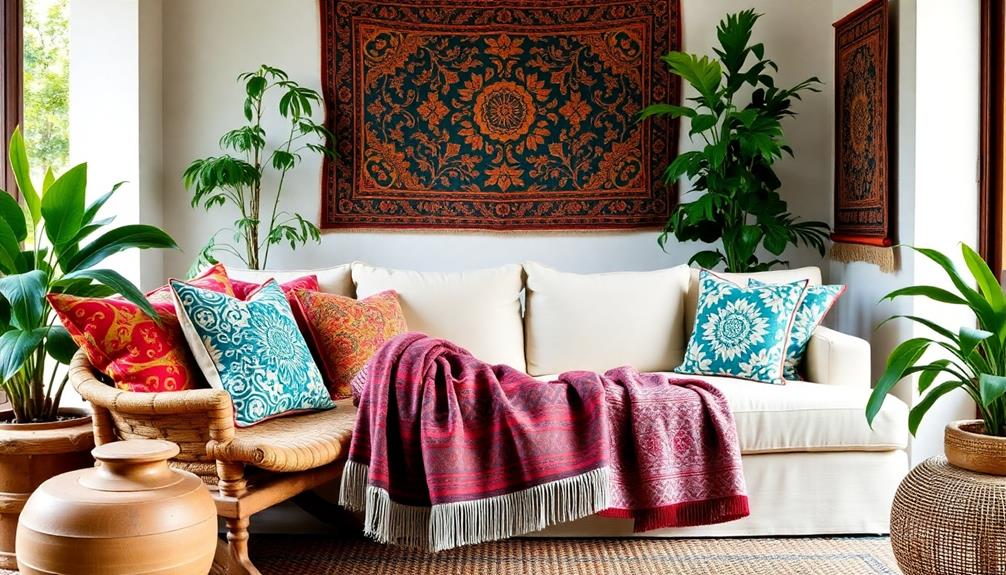
You can transform Indonesian fabrics into fashionable garments that blend tradition with modern style.
Consider incorporating traditional batik patterns into your home decor by creating stunning throw pillows or table linens that reflect the rich cultural heritage of Indonesia.
Think beyond clothing and consider how these textiles can enhance your home decor or become unique accessories.
With a little creativity, you'll find endless possibilities to showcase their beauty and craftsmanship, from using them in Indonesian wedding decor ideas to creating one-of-a-kind wall art.
Fashionable Garments Creation
Transforming Indonesian textiles into fashionable garments allows you to embrace vibrant colors and intricate patterns that stand out in any wardrobe.
Incorporating elements of traditional Indonesian style home decor can enhance the aesthetic appeal of your creations, reflecting the rich cultural heritage.
Utilizing unique fabrics like ikat and batik, you can create pieces that blend traditional artistry with contemporary fashion.
Here are some stylish ideas to contemplate:
- Elegant Dresses: Use handwoven ikat for chic, flowing dresses that make a statement.
- Sophisticated Tops: Craft stylish tops that highlight the intricate patterns of batik for a modern twist.
- Eye-Catching Accessories: Create scarves, handbags, or wraps from batik, adding a touch of elegance to any outfit.
- Chic Beachwear: Fashion sarongs and cover-ups from durable Indonesian textiles, perfect for beach outings.
Elegant Home Decor
Incorporating vibrant Indonesian fabrics into your home decor can instantly elevate any space, adding a touch of cultural richness and artistic flair. One of the most effective ways to do this is by creating stunning cushions from ikat fabrics.
These cushions not only add warmth but also showcase intricate floral and geometric shapes, enhancing both solid-colored and patterned furniture. Additionally, the use of natural materials and open designs in Balinese architecture can inspire the harmonious blend of indoor and outdoor aesthetics in your home decor, creating an inviting atmosphere that resonates with modern tropical aesthetics.
For your dining area, consider crafting unique table runners and placemats from batik textiles. Their intricate designs will elevate your dining experiences and spark conversations among guests.
You can even frame pieces of batik or ikat fabric as wall art, creating a striking focal point that celebrates cultural heritage.
If you're looking to transform your furniture, using Indonesian fabrics for upholstery on chairs or sofas can offer a chic, bohemian touch while highlighting the artistry of local artisans.
Additionally, handwoven scarves and wraps can serve as elegant accessories, seamlessly integrating traditional textiles into modern decor.
Unique Accessory Design
Immerse yourself in the world of unique accessory design by reimagining Indonesian fabrics like ikat and batik into stylish, functional pieces that tell a story.
These vibrant textiles not only add character to your home but also allow you to carry a piece of Indonesia's rich heritage with you. Whether it’s batik, ikat, or songket, each pattern and color scheme carries deep cultural significance, telling a unique story of the region from which it originates. Incorporating **Indonesian textiles for home decor** creates a warm, inviting space while also honoring centuries-old craftsmanship. By choosing these beautiful fabrics, you’re embracing both art and tradition, making your home truly one of a kind.
Consider incorporating Indonesian fabrics into your accessory collection with these creative ideas:
- Throw pillows made from ikat fabric, showcasing intricate floral patterns for a pop of color.
- Handwoven baskets that highlight the unique textures of batik, perfect for organizing or as decorative accents.
- Scarves crafted from durable ikat fabric, blending traditional artistry with contemporary style.
- Bags and totes featuring stunning batik designs, making everyday errands feel special.
Caring for Your Textiles
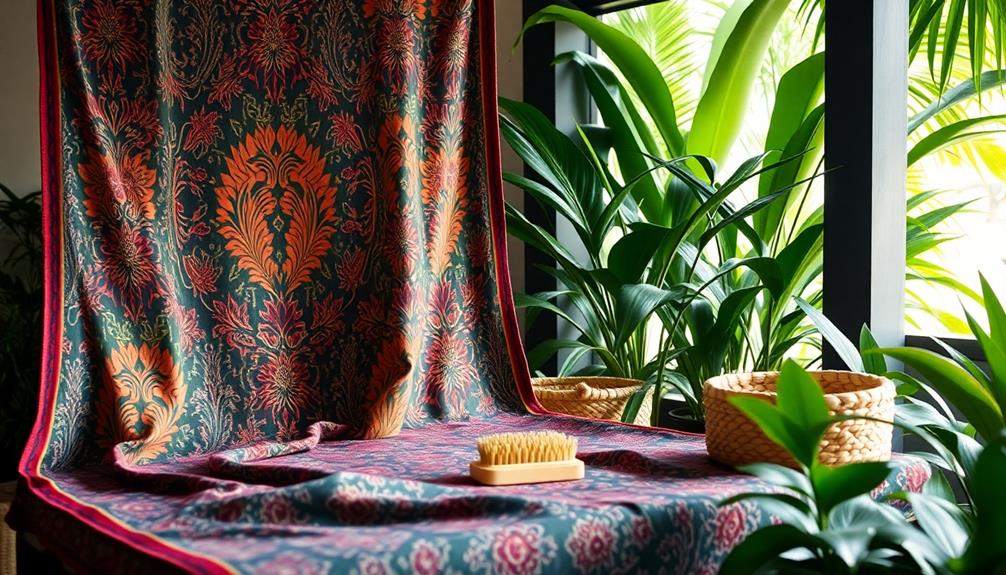
Caring for your Indonesian textiles is essential to keep their vibrant colors and intricate patterns looking fresh. Start by regularly spot cleaning with a mild detergent and a soft cloth to maintain vibrancy and tackle any stains. For larger pieces like rugs or curtains, consider professional cleaning to guarantee proper handling and long-lasting quality.
When it's time to store textiles, choose a cool, dry place away from direct sunlight to prevent fading and deterioration. Use breathable fabric bags or cotton sheets for protection. Additionally, rotate and fluff your textiles regularly to avoid uneven wear and help maintain their shape, especially for cushions and throws.
Always check care labels for specific washing and maintenance instructions, as different textile types, such as batik, ikat, and songket, may require unique approaches to care.
| Care Tip | Details |
|---|---|
| Spot Clean | Use mild detergent & soft cloth |
| Professional Cleaning | Recommended for large items |
| Storing | Keep in a cool, dry place |
| Rotating & Fluffing | Prevents uneven wear |
The Future of Indonesian Textile Artistry
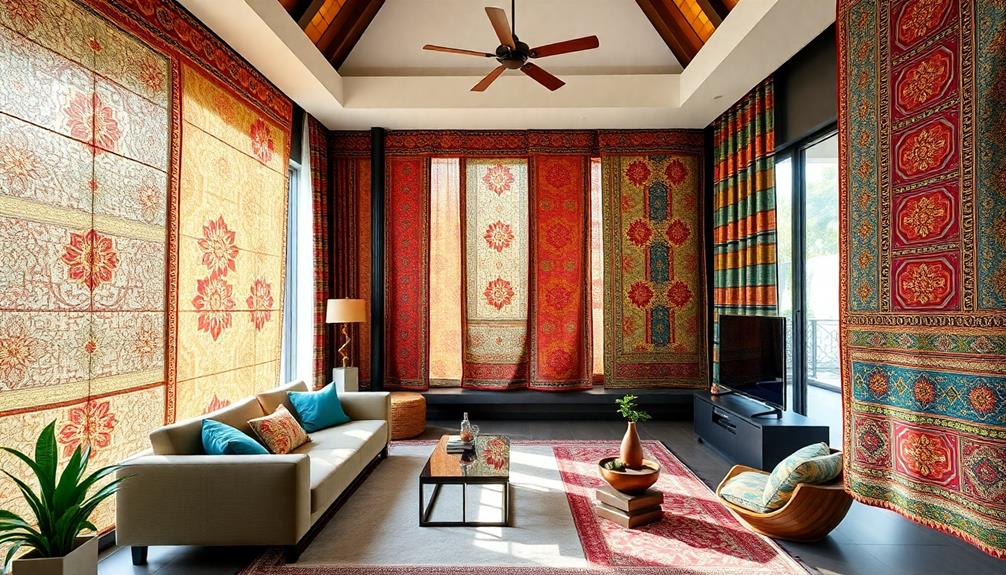
As you maintain your Indonesian textiles, it's exciting to see how the artistry behind them is evolving. The future of Indonesian textile artistry is being shaped by a strong focus on sustainability. Many artisans are adopting eco-friendly practices, guaranteeing their production processes minimize environmental impact.
Contemporary designers are creatively blending traditional techniques with modern aesthetics, bringing textiles like batik and ikat into the spotlight. This fusion not only preserves heritage but also attracts a new audience.
Here are some key trends to watch:
- Sustainability: Emphasis on eco-friendly materials and processes.
- Cultural Exchange: Increased global collaborations enhance visibility.
- Digital Innovation: E-commerce platforms broaden artisan reach.
- Preservation Efforts: Initiatives to document and teach traditional weaving techniques.
With international recognition growing, you'll find batik and ikat featured in high-profile fashion shows and art exhibitions.
These developments foster economic empowerment for artisans and guarantee the rich cultural heritage of Indonesian textiles remains vibrant for future generations. As you appreciate these textiles in your home, remember that you're part of a beautiful journey that honors tradition while embracing the future.
Frequently Asked Questions
What Is the Indonesian Textile Technique?
Indonesian textile techniques include batik, ikat, and songket. You'll find batik's wax-resist patterns fascinating, while ikat's vibrant threads catch your eye. Songket's luxurious gold and silver threads add elegance to any ceremonial attire.
What Are the Traditional Indonesian Textiles?
"Beauty's in the eye of the beholder." When exploring traditional Indonesian textiles, you'll discover batik, ikat, and songket, each showcasing unique patterns and techniques that reflect rich cultural heritage and artistry across the archipelago.
What Are the Fabric and Fabric Design of Indonesia?
Indonesian fabrics like ikat, batik, and songket showcase intricate designs and vibrant colors. You'll find patterns reflecting local myths and nature, each telling a story and adding cultural richness to your home decor.
How Big Is the Textile Industry in Indonesia?
The textile industry in Indonesia's massive, valued at around $10 billion. It employs over 1.5 million people, primarily in rural areas, and plays a crucial role in the nation's economy and cultural heritage.
Conclusion
Incorporating Indonesian textiles into your home not only adds timeless elegance but also connects you to a rich cultural heritage. Did you know that over 400 distinct textile traditions exist across Indonesia? By embracing these unique fabrics, you're not just enhancing your decor; you're also celebrating the artistry and stories behind each piece. So go ahead, explore the vibrant colors and intricate patterns, and let these textiles transform your space into a reflection of tradition and beauty.
